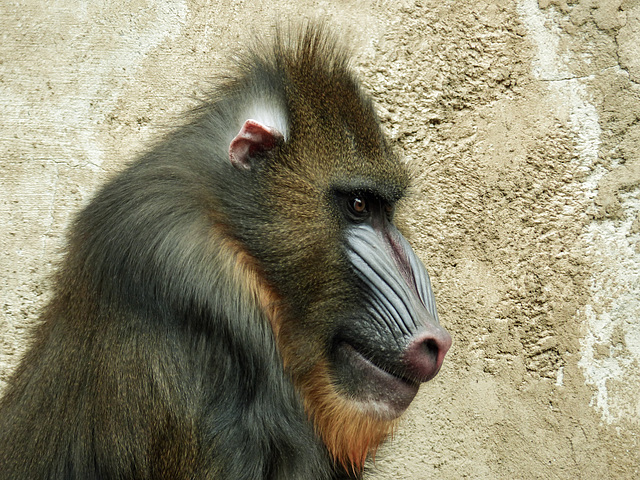See also...
Keywords
Authorizations, license
-
Visible by: Everyone -
All rights reserved
-
270 visits
Mandrill


I have been taking so few photos recently, so am now having to dig into my archives most of the time. The few times I have been out, I have either seen nothing or nothing that I can photograph. I am longing for a day out with tons of things to see and photograph : ) I'm quite sure there are many other people who are feeling just the same way!
This photo was taken through dirty glass at the Calgary Zoo on 28 September 2014. My last visit to the Zoo was about a year and a half ago, but hopefully these impressive animals are still there.
"The world’s largest monkey, mandrills in the wild are found in the rainforests of equatorial Africa in countries such as Guinea, Nigeria and Cameroon. Known for the vivid red, blue and yellow markings on the muzzle and rump, mandrills also have long canine teeth that make a memorable impression. The monkeys are largely ground-dwelling omnivores that forage on grubs, eggs, fruit, leaves and reptiles, but they will climb trees for fun or for a safe place to sleep. Mature males can weigh up to 50 kg. and live up to about 25 years of age. Their colours also get brighter as they mature.
Males can appear aggressive when they flash their canines at one another, but that is really a sign of friendly communication common in their complex social hierarchies, said Celli. In fact, despite their striking looks, mandrills tend to be quite shy. Because the group at the zoo is all male, you won’t see any displays of bravado that signal mating behaviour, but you will see the younger males following the lead of their dominant oldest brother, Yusufu. Zoo curator, Dr. Malu Celli, said the adolescent younger brothers will copy his mannerisms and even his walk.
The trio were born in captivity in the Granby Zoo in Granby, Q.C. and were part of a family group there that had too many males. Celli said it is not unusual to find bachelor groups of mandrills in the wild, or males that hang out on the peripheries of a “super group.” From an article in the Calgary Herald on 16 May 2014.
www.calgaryherald.com/technology/things+know+about+colour...
en.wikipedia.org/wiki/Mandrill
This photo was taken through dirty glass at the Calgary Zoo on 28 September 2014. My last visit to the Zoo was about a year and a half ago, but hopefully these impressive animals are still there.
"The world’s largest monkey, mandrills in the wild are found in the rainforests of equatorial Africa in countries such as Guinea, Nigeria and Cameroon. Known for the vivid red, blue and yellow markings on the muzzle and rump, mandrills also have long canine teeth that make a memorable impression. The monkeys are largely ground-dwelling omnivores that forage on grubs, eggs, fruit, leaves and reptiles, but they will climb trees for fun or for a safe place to sleep. Mature males can weigh up to 50 kg. and live up to about 25 years of age. Their colours also get brighter as they mature.
Males can appear aggressive when they flash their canines at one another, but that is really a sign of friendly communication common in their complex social hierarchies, said Celli. In fact, despite their striking looks, mandrills tend to be quite shy. Because the group at the zoo is all male, you won’t see any displays of bravado that signal mating behaviour, but you will see the younger males following the lead of their dominant oldest brother, Yusufu. Zoo curator, Dr. Malu Celli, said the adolescent younger brothers will copy his mannerisms and even his walk.
The trio were born in captivity in the Granby Zoo in Granby, Q.C. and were part of a family group there that had too many males. Celli said it is not unusual to find bachelor groups of mandrills in the wild, or males that hang out on the peripheries of a “super group.” From an article in the Calgary Herald on 16 May 2014.
www.calgaryherald.com/technology/things+know+about+colour...
en.wikipedia.org/wiki/Mandrill
autofantasia, Pam J have particularly liked this photo
- Keyboard shortcuts:
Jump to top
RSS feed- Latest comments - Subscribe to the comment feeds of this photo
- ipernity © 2007-2024
- Help & Contact
|
Club news
|
About ipernity
|
History |
ipernity Club & Prices |
Guide of good conduct
Donate | Group guidelines | Privacy policy | Terms of use | Statutes | In memoria -
Facebook
Twitter

Sign-in to write a comment.